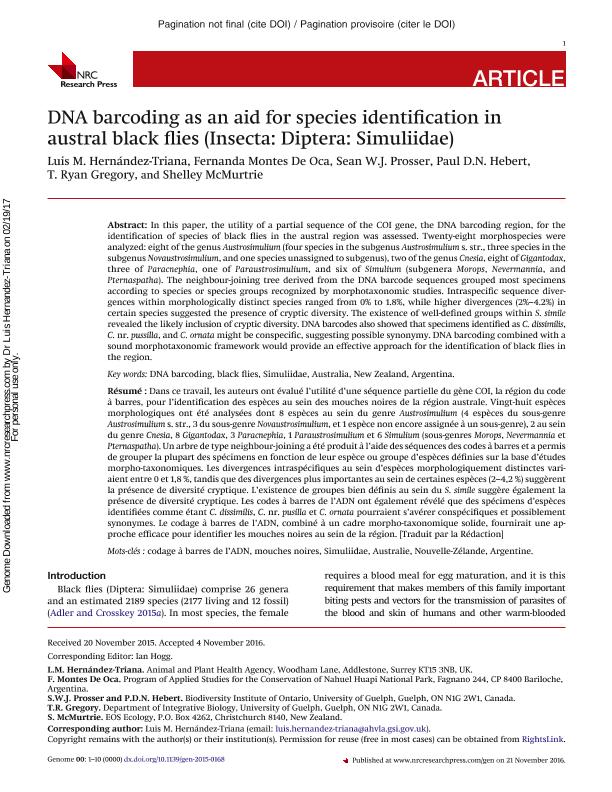Mostrar el registro sencillo del ítem
dc.contributor.author
Hernández Triana, Luis M.
dc.contributor.author
Montes de Oca, Fernanda

dc.contributor.author
Prosser, Sean W. J.
dc.contributor.author
Hebert, Paul David Neil

dc.contributor.author
Gregory, T. Ryan
dc.contributor.author
McMurtrie, Shelley
dc.date.available
2018-08-31T14:47:45Z
dc.date.issued
2017-01
dc.identifier.citation
Hernández Triana, Luis M.; Montes de Oca, Fernanda; Prosser, Sean W. J.; Hebert, Paul David Neil; Gregory, T. Ryan; et al.; DNA barcoding as an aid for species identification in austral black flies (Insecta: Diptera: Simuliidae); National Research Council Canada-NRC Research Press; Genome; 60; 4; 1-2017; 348-357
dc.identifier.issn
0831-2796
dc.identifier.uri
http://hdl.handle.net/11336/57860
dc.description.abstract
In this paper, the utility of a partial sequence of the COI gene, the DNA barcoding region, for the identification of species of black flies in the austral region was assessed. Twenty-eight morphospecies were analyzed: eight of the genus Austrosimulium (four species in the subgenus Austrosimulium s. str., three species in the subgenus Novaustrosimulium, and one species unassigned to subgenus), two of the genus Cnesia, eight of Gigantodax, three of Paracnephia, one of Paraustrosimulium, and six of Simulium (subgenera Morops, Nevermannia, and Pternaspatha). The neighbour-joining tree derived from the DNA barcode sequences grouped most specimens according to species or species groups recognized by morphotaxonomic studies. Intraspecific sequence divergences within morphologically distinct species ranged from 0% to 1.8%, while higher divergences (2%-4.2%) in certain species suggested the presence of cryptic diversity. The existence of well-defined groups within S. simile revealed the likely inclusion of cryptic diversity. DNA barcodes also showed that specimens identified as C. dissimilis, C. nr. pussilla, and C. ornata might be conspecific, suggesting possible synonymy. DNA barcoding combined with a sound morphotaxonomic framework would provide an effective approach for the identification of black flies in the region.
dc.format
application/pdf
dc.language.iso
eng
dc.publisher
National Research Council Canada-NRC Research Press

dc.rights
info:eu-repo/semantics/openAccess
dc.rights.uri
https://creativecommons.org/licenses/by-nc-sa/2.5/ar/
dc.subject
Argentina
dc.subject
Australia
dc.subject
Black Flies
dc.subject
Dna Barcoding
dc.subject
New Zealand
dc.subject
Simuliidae
dc.subject.classification
Otras Ciencias Biológicas

dc.subject.classification
Ciencias Biológicas

dc.subject.classification
CIENCIAS NATURALES Y EXACTAS

dc.title
DNA barcoding as an aid for species identification in austral black flies (Insecta: Diptera: Simuliidae)
dc.type
info:eu-repo/semantics/article
dc.type
info:ar-repo/semantics/artículo
dc.type
info:eu-repo/semantics/publishedVersion
dc.date.updated
2018-08-31T14:09:02Z
dc.journal.volume
60
dc.journal.number
4
dc.journal.pagination
348-357
dc.journal.pais
Canadá

dc.journal.ciudad
Otawa
dc.description.fil
Fil: Hernández Triana, Luis M.. Animal and Plant Health Agency; Reino Unido
dc.description.fil
Fil: Montes de Oca, Fernanda. Consejo Nacional de Investigaciones Científicas y Técnicas; Argentina. Administración de Parques Nacionales. Parque Nacional "Nahuel Huapi"; Argentina
dc.description.fil
Fil: Prosser, Sean W. J.. University of Guelph; Canadá
dc.description.fil
Fil: Hebert, Paul David Neil. University of Guelph; Canadá
dc.description.fil
Fil: Gregory, T. Ryan. University of Guelph; Canadá
dc.description.fil
Fil: McMurtrie, Shelley. EOS Ecology; Nueva Zelanda
dc.journal.title
Genome

dc.relation.alternativeid
info:eu-repo/semantics/altIdentifier/doi/https://dx.doi.org/10.1139/gen-2015-0168
dc.relation.alternativeid
info:eu-repo/semantics/altIdentifier/url/http://www.nrcresearchpress.com/doi/10.1139/gen-2015-0168#.W4lRmM4zbmg
Archivos asociados
